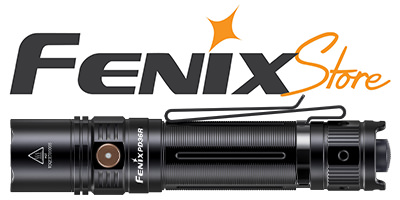Stress_Test
Flashlight Enthusiast
- Joined
- Feb 18, 2008
- Messages
- 1,334
Don't know if the Prometheus / FourSevens team have done any destructive testing or test-to-failure of Quarks before, but I came close to running such a test by accident! 
I've got an old 123^2 (9 volt) Quark with the warm / hi-cri emitter. I was using it with a 16650 just now to provide some bounce lighting while fooling around with my camera.
I had it on "turbo" (head tightened) and propped on a desk; not tail standing but the head was sticking up and not touching anything.
It was hot in the room (low 80s) since it was upstairs and it wasn't air-conditioned, but ambient temp shouldn't have really been an "unusual" case, because heck, often in the summer time, it'll still be 80 degrees F at 9pm!
I don't know exactly how long the light was sitting there on turbo. Maybe 10 or 15 minutes total? I was engrossed with the camera and didn't think about the light for a while until it suddenly hit me, "oh, I should turn that thing down"
I picked it up and it was HOT. Not too hot to hold, but unpleasantly hot. I turned it off, took the head off and the battery out so everything could cool down. It didn't take long to get back to ambient temp. I checked the battery to make sure nothing was abnormal and it showed about 3.9 volts, so no problems there.
I turned the light on again and didn't see any obvious issues such as tint shift. However, as I looked at the reflector, I noticed that one area close to the LED showed some discoloration, kind of like when steel has been welded and gets some wavy color.
On close inspection of the LED (as well as I could see with my eyes anyway) it looks like there's some charring or melting at the edge of the dome. I think the reflector may just be showing the LED flaw. I wouldn't think the aluminum reflector could've absorbed enough heat to discolor, but I don't have much experience in that arena.
No obvious defects in the beam color or profile. The hotspot is just slightly elongated / oblong a little bit, but it's not really noticeable unless shining on a blank wall, and even then I had to rotate the light back and forth to really notice it. Yay for orange-peel reflectors, right? I've seen worse beam patterns from lights brand-new from the box.
I've seen worse beam patterns from lights brand-new from the box.
Anyway, I thought this might be interesting to share from a technical standpoint. Most of us know in general that you don't want to leave a small, high-powered light sitting by itself on max for very long, but I've never before done it long enough to cause noticeable damage.
In another thread I was reading recently, regarding a 6xAA light, a member was flabbergasted as to why such a large light was used to generate "only" 700 lumens. Well, this proves that larger lights also have an advantage when it comes to heat dissipation.
For instance, I've got a triple-emitter, 6xAA Energizer light that has a max of 1200-ish lumens on high, and something like 200 to 250 on low. Just a few days ago, I ran that light for hours on the 200 lumen setting and it just barely got warmer than ambient, almost unnoticeable. Whereas the small Quark at 200 lumens started to cook itself after only 15 minutes or so. Sometimes larger lights do have an advantage!
I'll definitely be more mindful of using the full-power mode on my Quarks from now on.
I'll try to get some photos of the slightly-toasted emitter. I don't have an actual macro lens for the camera though, so I don't know if the burned area will show up or not.
I've got an old 123^2 (9 volt) Quark with the warm / hi-cri emitter. I was using it with a 16650 just now to provide some bounce lighting while fooling around with my camera.
I had it on "turbo" (head tightened) and propped on a desk; not tail standing but the head was sticking up and not touching anything.
It was hot in the room (low 80s) since it was upstairs and it wasn't air-conditioned, but ambient temp shouldn't have really been an "unusual" case, because heck, often in the summer time, it'll still be 80 degrees F at 9pm!
I don't know exactly how long the light was sitting there on turbo. Maybe 10 or 15 minutes total? I was engrossed with the camera and didn't think about the light for a while until it suddenly hit me, "oh, I should turn that thing down"
I picked it up and it was HOT. Not too hot to hold, but unpleasantly hot. I turned it off, took the head off and the battery out so everything could cool down. It didn't take long to get back to ambient temp. I checked the battery to make sure nothing was abnormal and it showed about 3.9 volts, so no problems there.
I turned the light on again and didn't see any obvious issues such as tint shift. However, as I looked at the reflector, I noticed that one area close to the LED showed some discoloration, kind of like when steel has been welded and gets some wavy color.
On close inspection of the LED (as well as I could see with my eyes anyway) it looks like there's some charring or melting at the edge of the dome. I think the reflector may just be showing the LED flaw. I wouldn't think the aluminum reflector could've absorbed enough heat to discolor, but I don't have much experience in that arena.
No obvious defects in the beam color or profile. The hotspot is just slightly elongated / oblong a little bit, but it's not really noticeable unless shining on a blank wall, and even then I had to rotate the light back and forth to really notice it. Yay for orange-peel reflectors, right?
Anyway, I thought this might be interesting to share from a technical standpoint. Most of us know in general that you don't want to leave a small, high-powered light sitting by itself on max for very long, but I've never before done it long enough to cause noticeable damage.
In another thread I was reading recently, regarding a 6xAA light, a member was flabbergasted as to why such a large light was used to generate "only" 700 lumens. Well, this proves that larger lights also have an advantage when it comes to heat dissipation.
For instance, I've got a triple-emitter, 6xAA Energizer light that has a max of 1200-ish lumens on high, and something like 200 to 250 on low. Just a few days ago, I ran that light for hours on the 200 lumen setting and it just barely got warmer than ambient, almost unnoticeable. Whereas the small Quark at 200 lumens started to cook itself after only 15 minutes or so. Sometimes larger lights do have an advantage!
I'll definitely be more mindful of using the full-power mode on my Quarks from now on.
I'll try to get some photos of the slightly-toasted emitter. I don't have an actual macro lens for the camera though, so I don't know if the burned area will show up or not.

